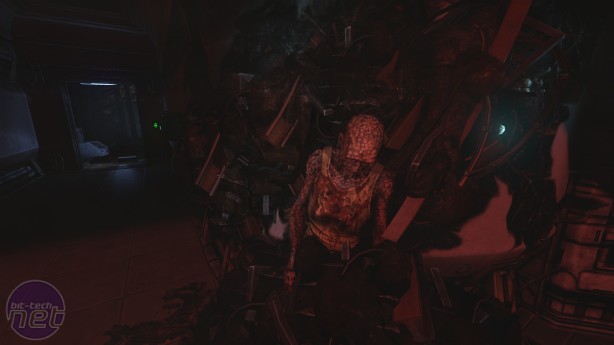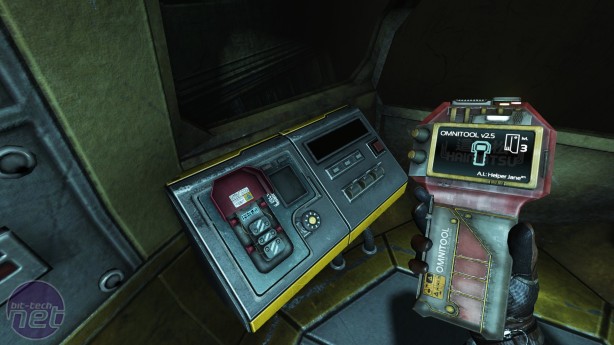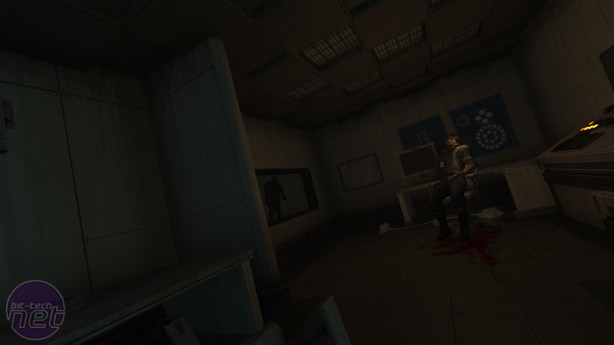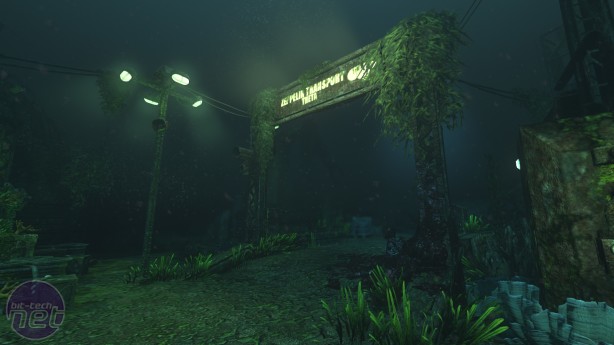
A particular highlight is Katherine, your primary companion throughout the game. Katherine is a former researcher at the station who is surprisingly accepting of the utterly dreadful situation she now finds herself in. It's safe to say that she has her flaws, but her upbeat manner and rational approach to problems is surprisingly soothing amid the ceaseless atmosphere of dread and decay. This, of course, makes the game all the more unsettling when you're separated from her. It's a clever bit of psychological manipulation - giving you this cheerful, likable character, then periodically tearing you away from her to highlight your complete isolation.
But the story has bigger ambitions that strong writing and characterisation. It poses various moral and philosophical quandaries, like what it means to be human and the nature of personal identity. The way it does this is fascinating - many other games would use such grand topics as devices for artsy ambiguity, before revealing in a dramatic twist that you're really a toaster or something. SOMA isn't like that. Its plot revelations are always clear cut, delivered with almost disorienting matter-of-factness. The emphasis is on the ramifications of that information, what it means to you as an individual.
At times SOMA encourages you to explore this morality directly through certain choices. An early example sees you encounter a broken robot trapped on some electrified rails. To proceed to your objective, you need to switch off the power by causing an electrical surge. This can be done either by pulling a lever that affects the rails, which will fry the robot or by locating another level through some dark and winding corridors that are very obviously horror ambush territory.
A simple enough decision. Except, this particular robot insists that it's human. Its angry exclamations and cries for help seem eerily genuine, and it seems unable to recognise its own metallic limbs. Whether you believe this creature or not, there's clearly some semblance of intelligence going on inside its boxy metal head.
SOMA doesn't seem to track these choices plot-wise, not in any obvious way at least. There's no "This Angry Robot Will Remember That" gimmickry. Again, it's more about how you feel about that decision rather than what implications it has for the story. I did expect there to be more of these choices, however, given they're what Frictional seemed most excited about in the run up to release.
This leads us to SOMA's biggest problem. It's quite a bitty game. There's no unifying mechanic, nothing that connects its various ideas together in a systemic sense while many of the systems that were present in earlier games have either been pared back or removed entirely.
SOMA's world is very tactile, using the same click-and-drag physics system seen in Frictional's earlier game. But the puzzles themselves aren't really physics based. Most of them instead revolve around repairing or re-starting different kinds of machinery. Early on I thought these might be tied together by the "Omni-tool". One of the few items you carry with you throughout the game, the Omni-tool is used mainly to open doors and activate
work-stations. But these are more or less its only functions. Everything else is done by hand.
Sitting between these puzzling sections are sequences where you're hunted through an environment by something horrible and angry. These parts are inconsistent in their quality. An early example which takes place underwater is probably the best conceived. The monster design is genuinely disturbing and the water limits both your vision and your movement, making you feel even more vulnerable than normal. Later sections feel comparatively lazy. There's one monster in particular whose silhouette resembles a meat ice-lolly, and once I had this thought in my head all the tension evaporated.
You can almost feel Frictional's reluctance to resort to these evasion sequences in its ambition to reach for something higher, so it's unsurprising that they're the weakest parts of the game. Nevertheless, given Frictional's decision to include them, these sections should be more interesting. By now the player should have some options other than huddling in a corner and staring at a wall texture before the spooky thing scuttles away. The fascinating insanity system pioneered in the first Amnesia has also been jettisoned, which is fine because I doubt it would make sense here. But there's nothing in its place, making the experience feel just a little hollow in terms of play.
SOMA has been a lengthy and difficult project for Frictional, and these difficulties, the conflict between what they want to do and what they feel obliged to do, reveal themselves in the final product. Nevertheless, its introspective and soulful tale of deep loss and slim hope is consistently gripping and well worth submerging yourself in despite the lack of a more systemic hook.
But the story has bigger ambitions that strong writing and characterisation. It poses various moral and philosophical quandaries, like what it means to be human and the nature of personal identity. The way it does this is fascinating - many other games would use such grand topics as devices for artsy ambiguity, before revealing in a dramatic twist that you're really a toaster or something. SOMA isn't like that. Its plot revelations are always clear cut, delivered with almost disorienting matter-of-factness. The emphasis is on the ramifications of that information, what it means to you as an individual.
At times SOMA encourages you to explore this morality directly through certain choices. An early example sees you encounter a broken robot trapped on some electrified rails. To proceed to your objective, you need to switch off the power by causing an electrical surge. This can be done either by pulling a lever that affects the rails, which will fry the robot or by locating another level through some dark and winding corridors that are very obviously horror ambush territory.
A simple enough decision. Except, this particular robot insists that it's human. Its angry exclamations and cries for help seem eerily genuine, and it seems unable to recognise its own metallic limbs. Whether you believe this creature or not, there's clearly some semblance of intelligence going on inside its boxy metal head.
SOMA doesn't seem to track these choices plot-wise, not in any obvious way at least. There's no "This Angry Robot Will Remember That" gimmickry. Again, it's more about how you feel about that decision rather than what implications it has for the story. I did expect there to be more of these choices, however, given they're what Frictional seemed most excited about in the run up to release.
This leads us to SOMA's biggest problem. It's quite a bitty game. There's no unifying mechanic, nothing that connects its various ideas together in a systemic sense while many of the systems that were present in earlier games have either been pared back or removed entirely.
SOMA's world is very tactile, using the same click-and-drag physics system seen in Frictional's earlier game. But the puzzles themselves aren't really physics based. Most of them instead revolve around repairing or re-starting different kinds of machinery. Early on I thought these might be tied together by the "Omni-tool". One of the few items you carry with you throughout the game, the Omni-tool is used mainly to open doors and activate
work-stations. But these are more or less its only functions. Everything else is done by hand.
Sitting between these puzzling sections are sequences where you're hunted through an environment by something horrible and angry. These parts are inconsistent in their quality. An early example which takes place underwater is probably the best conceived. The monster design is genuinely disturbing and the water limits both your vision and your movement, making you feel even more vulnerable than normal. Later sections feel comparatively lazy. There's one monster in particular whose silhouette resembles a meat ice-lolly, and once I had this thought in my head all the tension evaporated.
You can almost feel Frictional's reluctance to resort to these evasion sequences in its ambition to reach for something higher, so it's unsurprising that they're the weakest parts of the game. Nevertheless, given Frictional's decision to include them, these sections should be more interesting. By now the player should have some options other than huddling in a corner and staring at a wall texture before the spooky thing scuttles away. The fascinating insanity system pioneered in the first Amnesia has also been jettisoned, which is fine because I doubt it would make sense here. But there's nothing in its place, making the experience feel just a little hollow in terms of play.
SOMA has been a lengthy and difficult project for Frictional, and these difficulties, the conflict between what they want to do and what they feel obliged to do, reveal themselves in the final product. Nevertheless, its introspective and soulful tale of deep loss and slim hope is consistently gripping and well worth submerging yourself in despite the lack of a more systemic hook.
-
Overall83 / 100


MSI MPG Velox 100R Chassis Review
October 14 2021 | 15:04













Want to comment? Please log in.